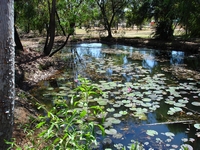Australia So Much to See


Pine Creek and Umbrawarra Gorge Nature Park
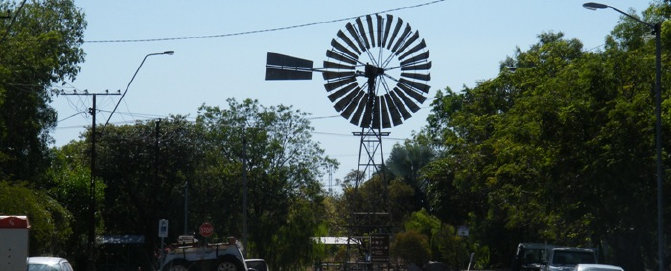
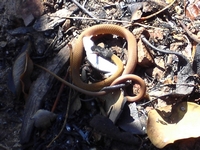
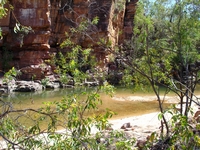
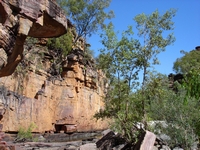
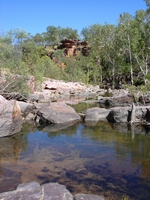
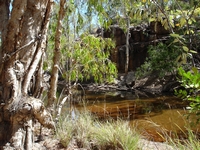
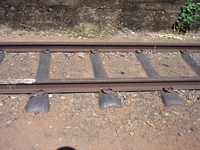
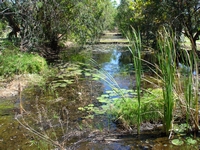

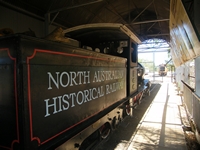
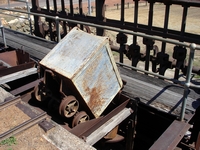
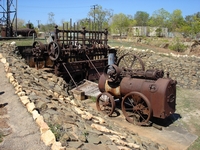
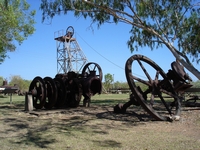
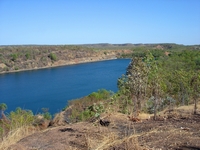
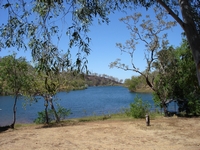
Heading towards Pine Creek we a visit Umbrawarra Gorge Nature Park, Copperfield Dam and on into the historic former mining town of
Pine Creek. Pine Creek is also the gateway to
Having just read “No Place for a Woman”, the story of Mayse Young, I was keen to see the town where, during
the ups and downs of her life, Mayse ran an outback Hotel. It is a book worth reading for anyone travelling through the north
of the
Being dependent on the fortunes
or failures of mining, Pine Creek has had a fluctuating past, and is now a small town just off the
Copperfield Dam
Accessed from the road to Umbrawarra, Copperfield Dam is now a picnic and recreation area. The area down
near the dam is well set out with grass and picnic tables and solar powered flood lighting at night. The dam is suitable for
swimming. Up on the hill there are toilets and an area which at the time of our visit permitted camping for up to eight rigs. This has subsequently been closed to camping due to misuse by some visitors.
Once a seasonal camping place for Aborigines, this gorge was discovered by members of the exploration party surveying the route for
the Overland Telegraph Line in the late 1870s.
The entrance to the gorge was the site of a tragic and unproductive tin
mine in the early 1900s, when over forty miners died from Malaria.
Gold was discovered near Pine Creek in 1871. A Government sponsored drilling project
began in 1906 but was abandoned in 1915 because of the War. In the 1960s the
The pit now forms a lake 135 metres deep and 250 metres wide at the widest point. It was filled with 6,800 megalitres of water
over fourteen months by diverting Pine Creek into the pit.
A lookout point not far from the town overlooks this man made
lake. Mining shafts are still evident on this hill.
The North South Transcontinental Railway
The railway was commenced in 1878 with a line from Port Augusta northwards, reaching
Farina in
During the War years
of 1942 to 1945, up to 147 trains per week passed through Pine Creek as Servicemen and equipment was transported between
In 1949 the Federal Government committed to converting the existing railways to standard
gauge and to link the northern and southern lines. However this never eventuated and the line to Birdum through Pine Creek was
closed in 1976 as the line was no longer considered viable. This was a big blow to the people of Pine Creek.
The
new Ghan railway linking
There
is a railway museum in the old Post Office, an outdoor locomotive display, and where the line ran though a cutting a park featuring
water gardens has been created. The locomotive on display is one of the locomotives which used to work on the line, an 1877
Beyer Peacock engine made in
Pine Creek and the South Alligator Region mining history
In 1845 Ludwig Leichhardt passed through the region on his epic journey
from the Darling Downs in Queensland to Port Essington on the Cobourg Peninsula; being the most northerly tip of the Northern Territory. Unknowingly, his geological description was of a region which was for 150 years one of the most productive mining regions in
1871 saw the discovery of gold around Pine Creek by the workers on the Overland Telegraph Line. With the lure of gold,
further discoveries were made and mining commenced in the Alligator Rivers region in the 1890s.
Further discoveries of
gold reefs continued through the 1920s with intermittent mining at Mundogie Hill and Yemelba. Mining on theses leases
ceased in the late 1930s when severe flooding washed away a network of bridges. This area is now principally within the
In the 1940s,
pastoralist Joe Callanan and prospectors the Roberts Brothers work a series of silver, copper, lead and zinc deposits. The Bureau
of Mineral Resources had already noted similarities in the geology of the
Twelve deposits in the South Alligator valley were worked
with the richest being El Sherana where a treatment plant for the region was opened in 1956. Gold was produced as a bi-product
of the ore. Mining to fill US and
In 1972, named after Uranium Development and Prospecting, UDP Falls was gazetted
as a Recreation Reserve. This is now known as
Uranium mining commenced in 1980 at the Jabiluka deposit and is currently being mined at the Ranger Mine,
with the lease being totally surrounded by the
In 1984 a mining resurgence saw gold, and more recently platinum and
palladium discovered and mined at Coronation Hill.
There are still active gold mines in the Pine Creek area, and a compound
of dongas houses mining workers, although the small town now thrives principally on tourism.
